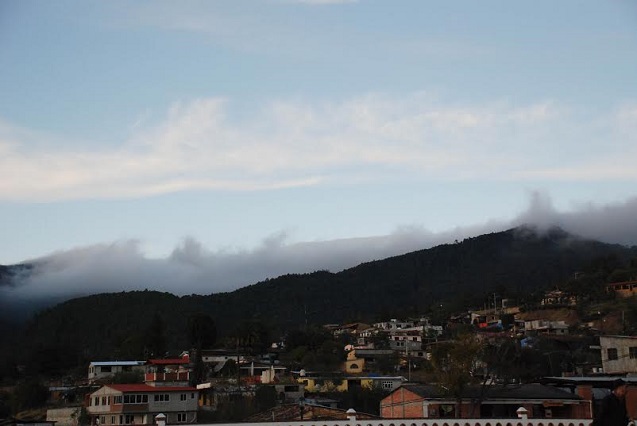
Also see: The Changing Map of Latin America
Also see: Mexico: Electoral Reform Threatens the Self-Determination of Indigenous Peoples
Communal Land and Autonomy
Entering into the heart of indigenous communities in the state of Oaxaca, Mexico, land of the Mixtecs and the Zapotecs, is like opening a door to a world of shapes, textures, colors and flavors that contrasts with the Western culture that governs daily life in big cities and westernized families. These indigenous communities are strongly tied to the mountains, to the smell of coffee that mixes with the smell of pines and the fragrance of flowers, to the legends that are woven by looms into clothing. All this takes place in lands that cannot be bought or owned.
If poetry, legends, clothing and food are the ways in which the ancestral culture of the indigenous Oaxacans is materialized and maintained, then “uses and customs” is the living expression of the political system of these communities, which has maintained its legitimacy historically, like any other state system. Of the 570 municipalities in the state of Oaxaca, 418 are governed through the traditional form of political organization of “uses and customs.” Only 152 have adopted a conventional system using political parties, a striking reality that is not just relevant in Mexico but in all of Latin America.
As an example, Bolivia is the country with the largest indigenous population in Latin America; according to the UN, 62 percent of Bolivians are part of an indigenous group. Only 11 local governments, however, are recognized as autonomous, with the right to elect their authorities through their own “uses and customs” system.
Oaxaca, one of Mexico’s 31 states, has the country’s highest level of diversity as well as the largest indigenous population. Of the 3.5 million inhabitants in the state, according to official statistics, more than one-third of the population is of indigenous origin (1,165,186 individuals). However, it wasn’t until 1995 that all the municipalities’ normative systems of “uses and customs” were legally recognized in Oaxaca’s state congress.
Each town has its owns rules about the best forms of organization; they are not homogenous. Despite the diversity of systems, two things are broadly characteristic of all of them: the cargo system and the assembly.
The assemblies, which are the highest decision-making bodies, are attended by all the heads of families, women and men, where they deliberate in person the town’s issues in order to arrive at consensus. Designated authorities preside over the assemblies. There are different levels of assembly: the domestic, neighborhood, the town council, the civil, the religious and the agrarian assemblies. The general assembly is the product and culmination of these previous assemblies. It is the maximum indigenous authority and it is the body that decides the rules that the govern community life.
Authorities are not elected through a traditional electoral system, but through a hierarchical system of cargos, which are unpaid positions that each member of the community must fulfill. In order to get to the position of mayor, a citizen would have to have served in a series of positions (cargos) throughout his or her life in the community. In general, individuals begin performing cargos at an early age. A 10-year-old child can start participating in community activities by doing some type of service in the church, ringing the daily bells that are used by the community as important daily markers of time, for example.
From there the process of transition from one cargo to the next begins, each one deliberated in the assembly. The communities in Guelatao de Juarez, inhabited by no more than 800 inhabitants, and Capulalpam de Mendez, with 1,500 inhabitants, located 60 kilometers from the capital city of Oaxaca in the Northern Sierra mountain range, are examples where these traditions are maintained. In these communities one begins in a position of topil (general assistant) or police assistant, then becomes a third-level council member or project manager, then second-level council member on education, ecology or health, followed by a first-level council member on taxes, community mediator and finally president.
There are two presidents. One is municipal, dedicated to the administration of the urban area, overseeing services like education, sewage and potable water. The other is the president or commissioner of communal resources, who administrates agrarian issues, such as communal land, since private property does not exist. There are also other cargos: mayor, treasurer and secretary. In Guelatao, there is a consulting board that is made up of elderly members of the community and people with experience who are well respected in the community.
In Guelatao, Jesus Hernandez Cruz just began his cargo as mayor. His hands, still rough from years as a small-scale farmer, grip a pencil and notebook where he takes his notes. He sits at a desk made of wood from the region. He was a professor and farmer for 34 years and retired in 2005, which is when he began his community service. He has a pension and continues to cultivate his tejocote fruit trees, from which he makes jellies.
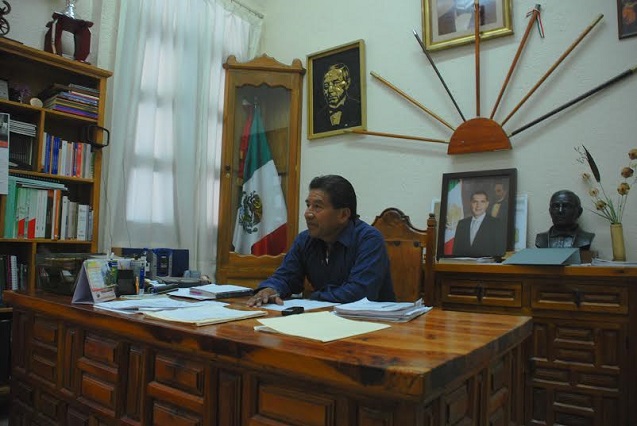 Jesus Hernandez Cruz, mayor of Juarez Guelatao. (Photo: Santiago Navarro F.)
Jesus Hernandez Cruz, mayor of Juarez Guelatao. (Photo: Santiago Navarro F.)
The mayor explained the logic of participating in cargos starting at the bottom, doing things like cleaning public spaces, before reaching a position like mayor. “The objective is that the person comes to understand the problems and needs of the community in order to be able to resolve them once they assume more important cargos. In this collective manner, each person is accommodated in certain activities according to their abilities. No one earns money here. In this way, one gains knowledge about the realities of the community. The only thing one earns as one completes a good service is the respect and recognition of the town,” he said.
In Guelatao, the inhabitants are compensated with services like water and public electricity that they don’t have to pay for. “Cargos are a service to the community, and in exchange, the community offers benefits to these citizens, such as gifts that are provided by the municipal authority in return for service. Because of this, it’s looked down upon if an individual does not fulfill his or her cargo and then comes back to the authority to ask for favors. If one does not want to fulfill the service – the cargo – without being compensated, it is preferable for this person to leave the town or that person will no longer enjoy these benefits,” writes Gabriela Canedo Vasquez, author of An Indigenous Conquest: Municipal Recognition of “Uses and Customs” in Oaxaca.
Community celebrations are also important times for the towns. Communities put on at least one celebration annually, where everyone participates and the assembly names a commission to be responsible for it, work which is also part of the cargo system.
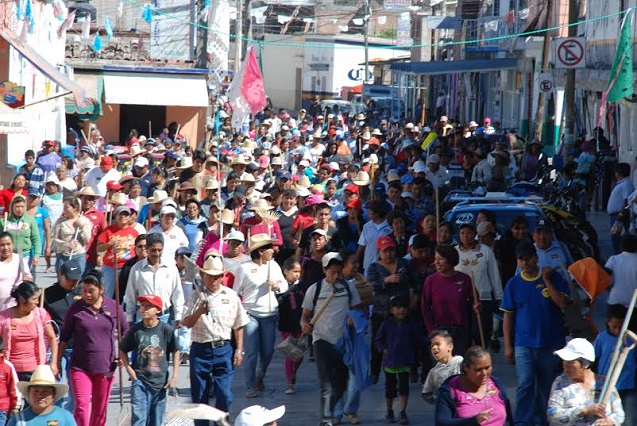 Collective work, cleaning the community in Nochixtlan, Oaxaca. (Photo: Santiago Navarro F.)
Collective work, cleaning the community in Nochixtlan, Oaxaca. (Photo: Santiago Navarro F.)
Foundations
Two means of community communication are the loud speakers that are usually located in the center of town and the community radio station. From there authorities announce festivals, assemblies and tequios, or collective work that is done for community benefit. “We recently invited everyone to clean the highway that marks the boundary with the community of Ixtlan. This type of service also serves to integrate people into a sense of community,” said Saúl Aquino Centeno, the commissioner of communal resources in Capulalpam de Mendez.
The elements that sustain the organizational community structure are the knowledge and values that have prevailed throughout their history. “We must understand what we are, not the ‘I’ or the ‘you,’ but the ‘we,’ and we should hold onto these principles in order to stop the interference of the vulgar and shameless principles of individualism. We shouldn’t enter into competition except to reproduce that which will be shared,” said Jaime Martínez Luna, an indigenous Zapotec anthropologist. “We are against development because it is linear and requires growth; we consider ourselves to be circular, in a spiral, and it’s because of this that men and women are not the center of the natural world. We are not owners of nature; we are owned by nature.”
Additionally, “Earth is considered to be our mother and we cannot do violence to her because she gives us life. We respect seeds because our grandparents taught us that they cry if they are not cared for; the grandparents say that the Mother Earth gives us food and when we die she receives and hugs us,” said Silvestre Ocaña López, of the indigenous group Tlahuitoltepec Mixes in Oaxaca, who does not hesitate to mark the difference between the way of thinking in her town and Western thinking. “Within the Western worldview, the earth is a product,” Ocaña López said. “For us in indigenous towns, we see it as our mother. She does not belong to us; we belong to her.”
Precedents
The indigenous rights lawyer Francisco López Bárcenas has immersed himself in the historical context of the indigenous communities of Oaxaca, and affirms that the debate about indigenous rights has existed since before the creation of the Mexican state. “It resumed on January 10, 1825, when the first Federal Constitution was being promulgated, which established in its fifth article that administratively it would be divided into counties, parties and towns; these last would be administrated by a city council made up of mayors, council members and mediators, as long as the town’s population reaches 3,000 ‘souls.’ In this way, the state of Oaxaca recognized the form of organization that indigenous communities had used since colonial times to resist Spanish oppression.”
In that sense López Bárcenas assumes that Oaxaca was the first state to pass legislation in the arena of indigenous rights, long before the Mexican government signed the UN’s ILO-Convention 169 regarding Indigenous and Tribal Communities in Independent Countries in 1989.
Communal Lands
The land in these towns is communal; it belongs to everyone. There is no private property, not even small plots are sold. The transference of land is done through a transfer of land rights. A father can transfer his land to his children, for example. Everything must go through the assembly. No one can sell the land and no one can buy it.
“If someone here works in the fields that individual is given a parcel of land. But that person must continually work the piece of land. If after three years nothing has been produced on the land, it is transferred to someone else who is interested in farming it. The commissioner is in charge of this,” explained the president of communal resources of Capulalpam.
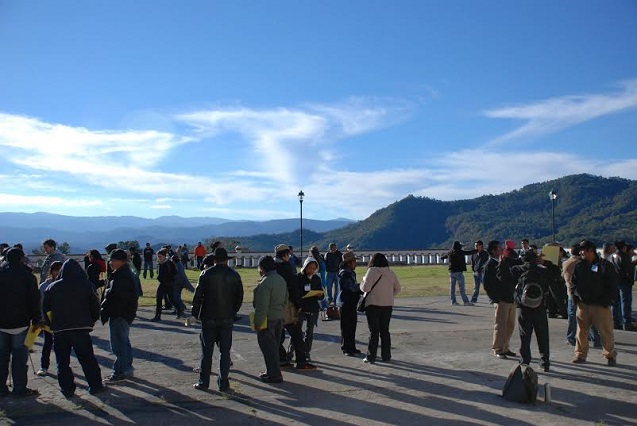 People’s discussion on mining in Capulalpam Mendez, northern highlands of Oaxaca. (Photo: Santiago Navarro F.)
People’s discussion on mining in Capulalpam Mendez, northern highlands of Oaxaca. (Photo: Santiago Navarro F.)
The assemblies can even decree protected communal areas. “We are updating the statute about communalism that governs communal resources. We are going to decree that an area where there are freshwater springs will be protected. We know that there are currently projects to take our land,” the commissioner said.
People that come from other communities cannot acquire land; they can only rent. Nor can they participate in the assembly system automatically. In Guelatao, “the person that moves here has the obligation to report himself or herself to the municipal government in order to be considered for community projects and cargos, but only once the decision has been made by the assembly that they can be accepted,” according to Guelatao’s mayor.
Justice
Guelatao also has a security protocol. “Here the punishments range from jail time – for eight hours, 12 hours, 24 hours, up to three days – fines or forced labor, and are for the benefit of the community. The mediator is the person directly responsible for justice in cases of physical violence, theft and crimes. The mayor is responsible for domestic lawsuits. He is the family mediator. He is also the person in charge of following up with problems that are outside the scope of the mediator. If a situation is very grave, it would require transferring the case to the Public Ministry. But the majority of cases are resolved here,” Cruz explained.
Community Projects
Guelatao’s mayor explained that the community also depends on federal and state resources. “There is an imposition of rules that must be followed with regard to funds destined for municipalities for social development. These resources come from the federal government, to be used for infrastructure and operations,” the mayor said.
In Capulalpam, they also receive outside resources, but fewer. “Communities have grown and improved with their own resources. [The town] is self-sufficient economically,” said the president of communal resources.
The self-sufficiency of the town is based in resources that are generated by five community businesses: a water bottling plant, a mill (there are forests that are managed sustainably within the community), a crushed-gravel pit, a toy factory and an ecotourism project. “Each project has its own administration. The assembly chooses a commission that accompanies each of them. Each project must report to the commissioner regarding economic developments and requests, which are brought up for approval in the assembly, usually every four months,” the president said.
The profits are used for social benefit. “No comunero (individuals who administrate and have historically had the right to use or cede communal lands) or citizen receives direct economic support or benefit. Resources are divided according to the needs of the community. The municipal government has some employees, such as a gardener, librarian [and] a person in charge of the cultural center. The project gives a certain amount of money to pay these people,” he added.
But Is It Autonomy?
Little is spoken about autonomy as a concept among people of these communities, although a definition is sought after in academic spaces. It’s possible that a complete concept has not been constructed that includes all the nuances and lived experiences of these towns. It simply manifests in the inter-subjective relationship between human and nature, and how social relationships are mitigated by this relationship to territory, or the Mother Earth, as they call it.
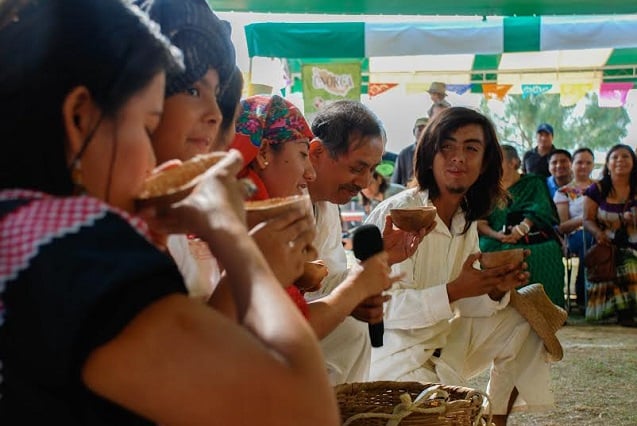 Theatrical representation of gratitude to Mother Earth; the meeting of people in defense of native corn. In the central valleys of Oaxaca. (Photo: Santiago Navarro F.)
Theatrical representation of gratitude to Mother Earth; the meeting of people in defense of native corn. In the central valleys of Oaxaca. (Photo: Santiago Navarro F.)
Autonomy seems to be a daily reality that is breathed and felt in the harmony of the people when they go to participate in the tequio – collective work – or when they attend an assembly, organize to defend their land and territory, and celebrate and dance. The cargos of self-governance are still seen as a symbol of respect for the person who is chosen to give the service without being paid.
The mayor of Guelatao recognizes the existence of a political and social organizational autonomy, but is critical of the role of state and federal government resources in communities. “The government is involved in everything, since they began collecting taxes and issuing public forms of credit. Before the farmer had the field entirely; in that moment we were autonomous. We produced and we provided for ourselves. We didn’t need any resources from the government. Town administration questions were handled through community cooperation. Now we aren’t 100 percent autonomous because we depend on resources from the government,” the mayor said.
For Martínez Luna, the anthropologist, autonomy is determined by the degree to which communities guarantee their own food sovereignty. “Autonomy shouldn’t be something that is injected from the outside; it should come from our own capacities – exercised, not developed.”
According to Martínez Luna, two other things are necessary to guarantee autonomy. “We have to value what we are because it is in this way that we value what we have, because this allows us to flourish fully. We have to think in a decolonized manner.” Community education is another route. “The value of individualism has been introduced into our way of being; it exists, but we have to fight to eliminate it through community education. Because I am not ‘I’ or ‘you,’ we are ‘us.'”
Threats
Some indigenous communities have been infiltrated by political parties, both from the left and the right, who offer food vouchers and place conditions on governmental economic support that would have had to be provided to small-scale farmers and indigenous individuals anyway. Another influencing factor is that deals are made between construction companies and local governments where the company gives a percentage of their budget designated for a public works project to the authorities or community representatives so that they will accept the project. In some cases, when budgets are larger, such as in the case of wind farm companies, hitmen are contracted or paramilitary groups are created to confront the community and thus give a justification for the interference of the state to re-establish “law and order,” to such a degree that there are indigenous leaders that have been assassinated for refusing to accept these projects.
“We recognize that we must confront the plundering by transnational companies and the harassment of bad governments through their political parties that offer programs and money that corrupt many leaders and divide our communities,” states the declaration of the National Indigenous Congress (CNI) of the Isthmus region, which took place in March 2014.
While a furious battle has been unleashed for the recognition of indigenous rights and culture in other communities in Mexico and Latin America, in Oaxaca, new legislation is being debated on this very theme while large-scale projects continue to advance.
Join us in defending the truth before it’s too late
The future of independent journalism is uncertain, and the consequences of losing it are too grave to ignore. We have hours left to raise the $12,0000 still needed to ensure Truthout remains safe, strong, and free. Every dollar raised goes directly toward the costs of producing news you can trust.
Please give what you can — because by supporting us with a tax-deductible donation, you’re not just preserving a source of news, you’re helping to safeguard what’s left of our democracy.